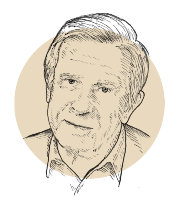The imposing, origami-like shape of the Albert Kahn Museum appears at the exit to the Boulogne Pont de Saint-Cloud subway station, on the southwest edge of the French capital. This institution celebrates the Alsace-born banker and philanthropist (no relation to his American homonyms, an architect from Detroit and a famous reporter), who lived in this leafy, residential neighborhood of Boulogne-Billancourt at the turn of the 20th century, and who created gardens reflecting his ideal of a harmonious world.
The enigmatic businessman was born in 1860. His father was a cattle dealer and his mother was a homemaker, but the self-taught Albert Kahn acquired his enormous wealth as a traveling investment banker. He was introduced to the mining industry, which he invested in for Europe, by his trips to South Africa, and discovered finance through his passion for Japan, which he first visited in 1897. He then launched Japanese bonds in France to support Japan in its war against Russia.
Just like in Around the World in 80 Days, Jules Verne’s book about the adventures of English gentleman Phileas Fogg and his faithful servant Jean Passepartout, Albert Kahn traveled the world with Albert Dutertre, his driver and mechanic who was also a trained photographer, and Maurice Lévy, his business manager. The billionaire developed his love of gardens in these far-flung lands that the West still knew very little about. In Boulogne, where he purchased a mansion in brick and stone near the Rothschild family’s château, he patiently bought up plots of land belonging to his neighbors.
A Natural Sanctuary on the Edge of Paris
Working with the finest architects of the time, he created a landscaped garden with different themes spanning ten acres, offering a world tour in the few hours it took to visit it. This collector’s garden featured six successive ecosystems, including an orchard and rose garden from a jardin à la française, fir trees and granite boulders from a forest in the Vosges Mountains, an artificial river and a cottage from an English garden, and Atlas cedars and Colorado spruces from a blue forest. One of the most magnificent highlights was a Japanese garden of maples and weeping beeches, complete with a river and a red bridge – a downscaled reproduction of the famous Shinkyo Bridge in Nikko.






The American tycoons of the Gilded Age, contemporaries of Albert Kahn, all had their eyes on Europe. They were fascinated by its architecture, its aesthetic, and the lifestyles of its royal families. Kahn, however, was already a global figure. Much like his international vision, his “world garden,” focused both on botany and beauty, was a kaleidoscope of atmospheres, colors, and scents, steeped in an “elixir of peace.” This passion for the exotic was combined with a keen curiosity about the people who lived in these foreign lands. This dual interest led to his immense documentary project, the Archives of the Planet. Between 1909 and 1931, he provided a dozen operators with film and photography equipment, and sent them all over the world with a single order: “Keep your eyes wide open.”
This visual inventory was supposed to be both geographic and ethnographic, without neglecting the trip’s exotic dimension or current affairs of the time. The result – 111 miles of silent film reel, 4,000 stereoscopic plates, and 72,000 autochrome plates, the first process used to produce color photographs – is “a living picture of life in our time,” said geographer Jean Brunhes, the scientific director of the project. The incomparable collection of images portrays daily life, religious and cultural practices, and political events in some 50 countries, including Spain, Egypt, the Balkans, Mongolia, and Japan, as well as in Paris and Brittany! As a friend of many politicians, artists, and writers, Albert Kahn also hosted screenings for them in his gardens, with guests such as Rodin, Colette, Auguste Renoir, Henri Bergson, and Indian Nobel Prize-winner Rabindranath Tagore.
A Brand-New Museum
The crash of 1929 cut the dream short. A ruined Albert Kahn had to call his operators home and his property in Boulogne-Billancourt was seized. However, the philanthropist was allowed to continue living there, and spent his final years like “a ghost within its walls” until his death on November 14, 1940. As he was registered as a Jew by the Nazi occupiers, he was buried unceremoniously in a mass grave. Recognition finally came in 1986, when the gardens and all his collections were granted Museum of France status, while a first exhibition gallery was opened four years later.
In 2013, Japanese architect Kengo Kuma won the call for bids for the new Albert Kahn Museum featuring a permanent visitor experience. He wanted to reinvent the longstanding Japanese tradition through the eyes of the 21st century, and this ensemble has just opened to the public. Arranged around the Japanese concept of engawa – a hanging indoor veranda – the 25,000 square-foot building is arranged into staggered levels. Trellised panels made with light-colored oak strips filter the light and the views of the garden, while the street-facing side is protected from the noise of the city and civilization by a steel screen.
Starting in September, visitors will also be able to enjoy a rooftop restaurant and a terrace overlooking the lush, green garden, and kiosks are set to open around the park. This natural slice of paradise is nestled in the heart of the “Valley of Culture,” a project led by the Hauts-de-Seine département, which includes the Seine Musicale auditorium on Ile Seguin, the Jardin des Métiers d’Art et du Design in Sèvres, and, in 2025, the Musée du Grand Siècle in Saint-Cloud. All good reasons to leave Paris and discover the marvels in its surrounding areas!
Article published in the July 2022 issue of France-Amérique. Subscribe to the magazine.












